Health And Fitness
8 Yoga Poses to Melt Away Stress

Yoga, a practice rooted in ancient traditions, has evolved into a global phenomenon renowned for its numerous physical and mental health benefits. From its origins codified by the Hindu sage Patañjali to its current form, yoga has significantly impacted how people manage their health and well-being. This article delves into the history of yoga, its core elements, and the scientifically backed benefits that make it a powerful tool for both body and mind.
The Origins of Yoga: A Brief History
The roots of yoga date back to between the 1st and 5th century CE, when the sage Patañjali began to compile the meditative practices prevalent across India. He documented these techniques in the Yoga Sutras, a collection of 196 manuals that define yoga as the “yoking” or restraining of the mind from external distractions, aiming to reach a state of pure consciousness. Initially focused on mental discipline, yoga later incorporated physical aspects drawn from gymnastics and wrestling.
Core Elements of Yoga
Modern yoga retains three core components from Patañjali’s original practice:
- Physical Postures (Asanas): These enhance flexibility, strength, and balance.
- Breathing Exercises (Pranayama): These regulate breath control to improve respiratory function and focus.
- Spiritual Contemplation (Meditation): This aspect fosters mindfulness and inner peace, promoting psychological well-being.
These elements combine physical and mental exercises that are believed to offer unique health benefits, from improving muscle tone to enhancing lung function.
Health Benefits of Yoga: What Does Science Say?
Although yoga’s popularity is bolstered by anecdotal evidence of its benefits, scientific studies provide mixed results due to varying methodologies, small sample sizes, and the subjective nature of self-reporting. However, there are specific health advantages with robust scientific support.
1. Improved Flexibility and Strength
Yoga’s physical postures stretch multiple muscle groups, improving flexibility and strength. Regular stretching alters the water content in muscles, ligaments, and tendons, making them more elastic. Over time, stretching stimulates stem cells that differentiate into new muscle tissues and collagen, enhancing overall flexibility. Unlike other exercises, yoga also reduces the body’s natural reflex to constrict muscles, increasing pain tolerance and mobility.
Studies show that yoga can effectively reduce pain and enhance mobility in individuals with musculoskeletal disorders, making it a preferred choice over other low-impact exercises.
2. Therapeutic Benefits for Chronic Conditions
Yoga has shown potential as a therapeutic intervention for chronic conditions such as lower back pain, rheumatoid arthritis, and osteoporosis. By integrating yoga into existing exercise routines, individuals can experience reduced pain and increased strength, contributing to better management of these hard-to-treat conditions.
3. Enhanced Lung and Heart Health
Yoga breathing exercises are particularly beneficial for those with lung conditions like chronic bronchitis, emphysema, and asthma. These exercises help relax muscles that constrict airways and improve oxygen diffusion into the bloodstream. For individuals with weak heart muscles, increased oxygen content in the blood can significantly enhance overall cardiovascular function.
For those with healthy hearts, regular yoga practice has been linked to lower blood pressure and a reduced risk of cardiovascular diseases.
4. Psychological Benefits and Mental Health
One of yoga’s most celebrated yet least scientifically proven benefits is its positive impact on mental health. Although the practice is widely associated with reduced symptoms of anxiety and depression, conclusive evidence remains limited due to the variability in diagnoses and the subjective nature of psychological well-being.
However, yoga is recognized for its ability to alleviate stress, comparable to meditation and relaxation techniques. This stress reduction can significantly impact overall mental health, promoting a sense of calm and relaxation.
Challenges in Measuring Yoga’s Impact
Despite numerous studies, yoga’s unique combination of physical and mental exercises makes it challenging to pinpoint which component yields specific health benefits. Additionally, research often involves small, homogenous sample sizes, leading to less generalizable results. Future research needs to incorporate larger, more diverse participant groups to measure yoga’s effects on serious health conditions like heart disease, cancer, and cognitive decline.
Yoga Poses for Stress Relief
Pose 1: Child’s Pose (Balasana)

Image source: yogajournal
Benefits of Child’s Pose
Child’s Pose offers a sanctuary for the mind and body. This pose provides relief for the back and shoulders. The gentle stretch helps release tension. Practicing this pose calms the mind and promotes relaxation. Research highlights that yoga connects the body and mind, enhancing calmness. Child’s Pose embodies this principle by encouraging deep breathing and mindfulness.
Step-by-Step Instructions
- Kneel on the floor with your big toes touching.
- Sit back on your heels.
- Spread your knees hip-width apart.
- Exhale and lay your torso between your thighs.
- Extend your arms forward with palms facing down.
- Rest your forehead on the mat.
- Breathe deeply and hold the pose for several breaths.
Pose 2: Cat-Cow Pose (Marjaryasana-Bitilasana)
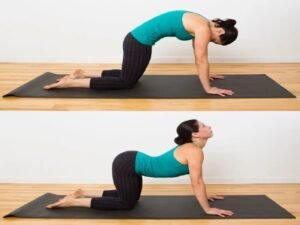
Image source: popsugar
Benefits of Cat-Cow Pose
Cat-Cow Pose improves flexibility in the spine. This movement encourages deep breathing. The rhythmic flow helps alleviate stress. Yoga Instructor Jain emphasizes improved circulation and breathing through yoga. Cat-Cow Pose embodies these benefits by promoting fluid motion and relaxation.
Step-by-Step Instructions
- Start on your hands and knees in a tabletop position.
- Align your wrists under your shoulders and knees under your hips.
- Inhale and arch your back, lifting your head and tailbone (Cow Pose).
- Exhale and round your spine, tucking your chin to your chest (Cat Pose).
- Continue to alternate between Cat and Cow poses.
- Synchronize your breath with each movement.
- Repeat for several breaths.
Pose 3: Downward Facing Dog Pose (Adho Mukha Svanasana)
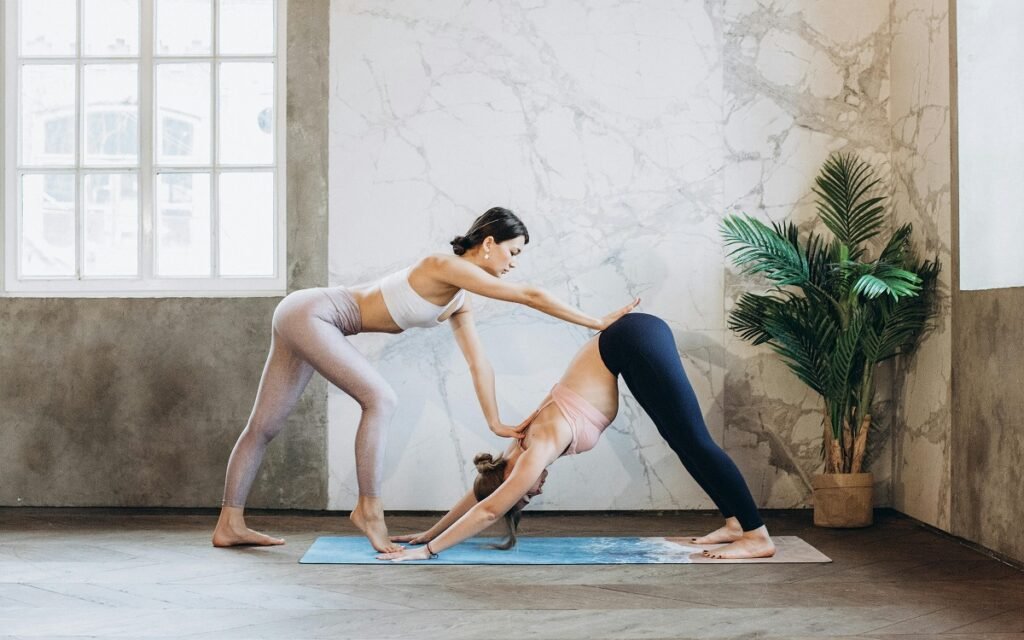
Image source: pexels
Benefits of Downward Facing Dog Pose
Downward Facing Dog Pose stretches the spine and relieves tension. This pose strengthens the arms and legs. Practicing this pose enhances circulation and reduces stress. Studies show that yoga balances the body and mind connection. Downward Facing Dog exemplifies this balance by promoting both strength and relaxation.
Step-by-Step Instructions
- Begin on your hands and knees in a tabletop position.
- Tuck your toes under and lift your hips toward the ceiling.
- Straighten your legs and press your heels toward the floor.
- Spread your fingers wide and press into the mat.
- Keep your head between your arms, ears aligned with upper arms.
- Hold the pose for several breaths, focusing on deep breathing.
Pose 4: Legs-Up-the-Wall Pose (Viparita Karani)
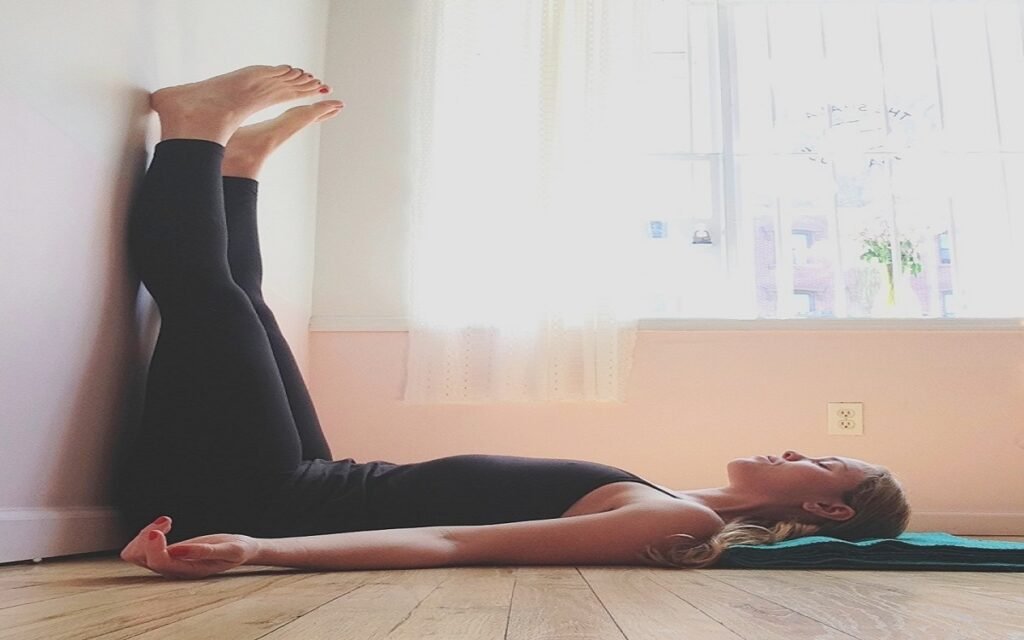
Image Source: shvasa
Benefits of Legs-Up-the-Wall Pose
Legs-Up-the-Wall Pose offers a soothing experience for both body and mind. This pose encourages relaxation by elevating the legs, which helps reduce swelling and fatigue. Practicing this pose promotes improved circulation and calms the nervous system. Studies highlight that yoga strengthens the connection between body and mind. Legs-Up-the-Wall Pose embodies this principle by fostering a sense of tranquility and grounding.
Step-by-Step Instructions
- Sit sideways against a wall with your hips close to the wall.
- Lie back and swing your legs up onto the wall.
- Adjust your position so your body forms an L-shape.
- Rest your arms at your sides with palms facing up.
- Close your eyes and breathe deeply.
- Hold the pose for several minutes, focusing on relaxation.
Pose 5: Corpse Pose (Savasana)
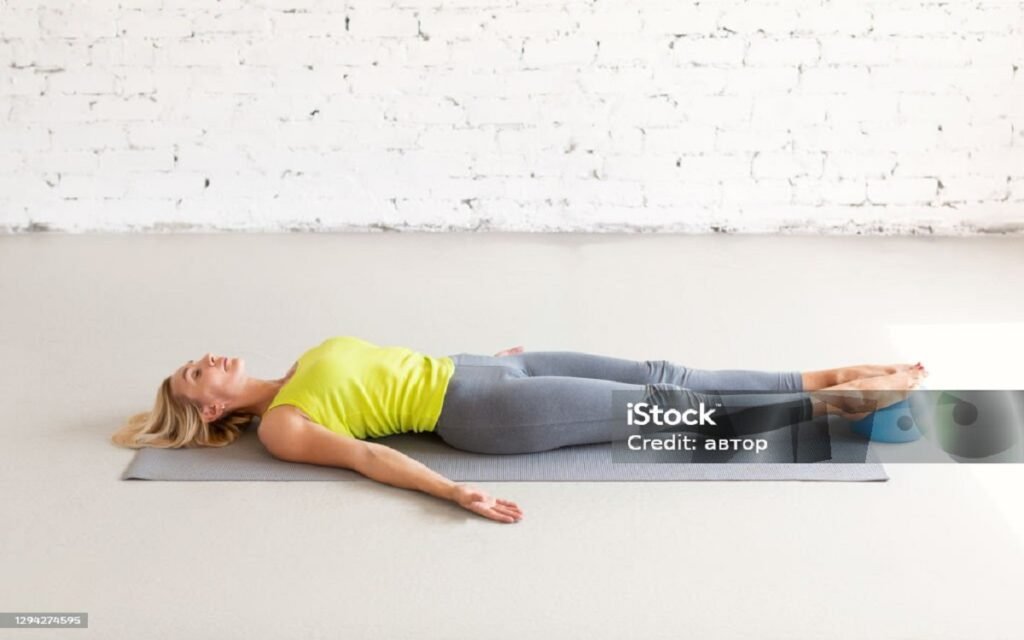
Image Source: istockphoto
Benefits of Corpse Pose
Corpse Pose serves as the ultimate relaxation pose in yoga. This pose allows the body to absorb the benefits of the practice. Savasana encourages deep relaxation and stress relief. Yoga Instructor Jain emphasizes the importance of relaxation for improving overall well-being. Corpse Pose provides a moment of stillness and peace, enhancing mental clarity and emotional balance.
Step-by-Step Instructions
- Lie flat on your back with arms at your sides.
- Spread your legs slightly apart.
- Let your feet fall open naturally.
- Close your eyes and take slow, deep breaths.
- Focus on releasing tension from each part of your body.
- Remain in the pose for five to ten minutes.
Pose 6: Bridge Pose (Setu Bandha Sarvangasana)
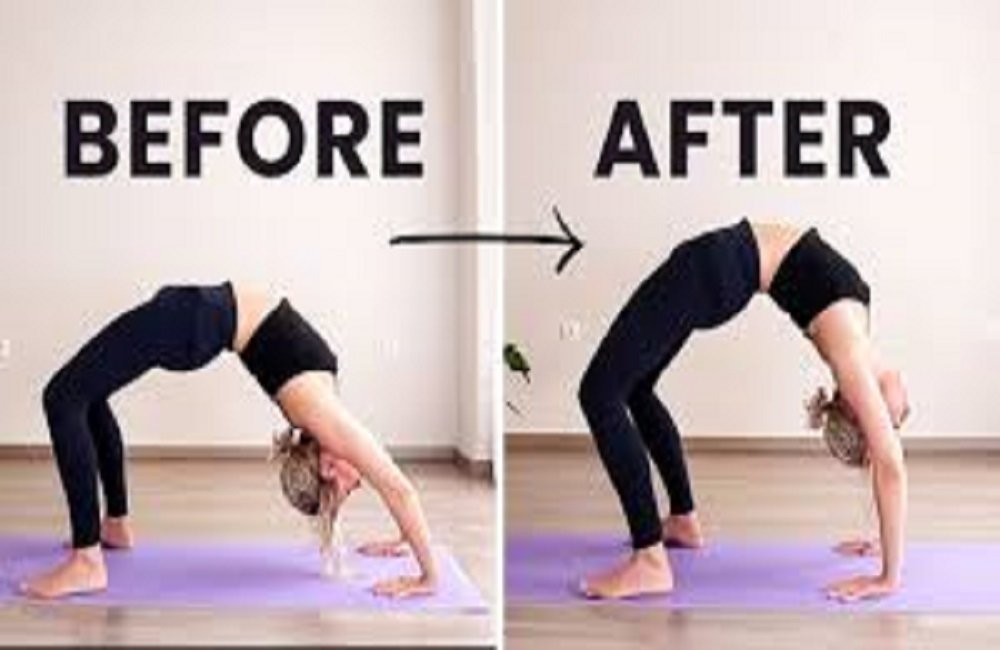
Benefits of Bridge Pose
Bridge Pose opens the chest and stretches the spine. This pose strengthens the back muscles and improves posture. Practicing Bridge Pose enhances flexibility and reduces anxiety. Studies reveal that yoga supports a balanced body and mind connection. Bridge Pose exemplifies this balance by promoting strength and relaxation.
Step-by-Step Instructions
- Lie on your back with knees bent and feet hip-width apart.
- Place your arms at your sides with palms facing down.
- Press your feet into the mat and lift your hips toward the ceiling.
- Keep your thighs parallel and engage your core.
- Hold the pose for several breaths, focusing on deep breathing.
- Lower your hips slowly back to the mat.
Pose 7: Happy Baby Pose (Ananda Balasana)
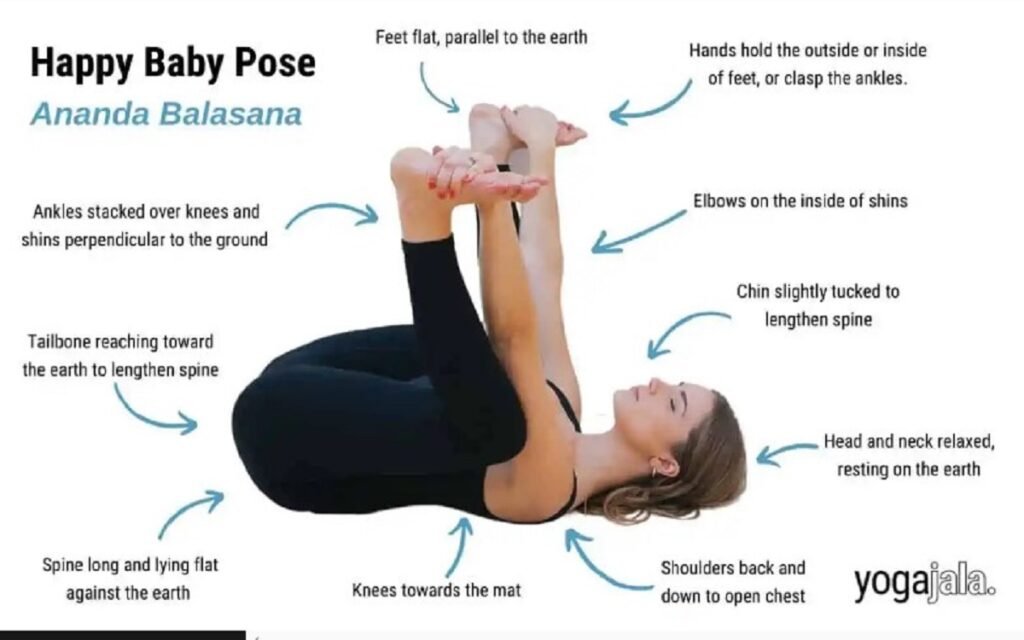
Image Source: yogajala
Benefits of Happy Baby Pose
Happy Baby Pose brings joy and relaxation to your practice. This pose gently stretches the hips and lower back. The stretch helps release tension and promotes a sense of calm. Yoga Instructor Jain highlights that yoga improves circulation and breathing. Happy Baby Pose embodies these benefits by encouraging deep, mindful breaths. Practicing this pose enhances flexibility and supports overall health and fitness.
Step-by-Step Instructions
- Lie on your back with your knees bent.
- Draw your knees toward your chest.
- Hold the outer edges of your feet with your hands.
- Open your knees wider than your torso.
- Press your feet into your hands while pulling down with your hands.
- Keep your head and shoulders relaxed on the mat.
- Breathe deeply and hold the pose for several breaths.
Pose 8: Extended Triangle Pose (Utthita Trikonasana)

Image Source: omstars
Benefits of Extended Triangle Pose
Extended Triangle Pose offers a powerful stretch for the sides of your body. This pose improves balance and stability. Practicing this pose enhances mental clarity and focus. Studies show that yoga strengthens the connection between body and mind. Extended Triangle Pose exemplifies this connection by promoting both physical and mental balance. This pose contributes to a sense of calm and well-being.
Step-by-Step Instructions
- Stand with your feet wide apart.
- Turn your right foot out and your left foot slightly in.
- Extend your arms parallel to the floor.
- Reach your right hand toward your right foot.
- Place your right hand on your shin or ankle.
- Stretch your left arm toward the ceiling.
- Look up at your left hand and hold the pose for several breaths.
Yoga in these various poses brings about numerous benefits, not only for the purpose of taking relief from stress but also for overall well-being. Each of these poses demonstrates one form of physical relaxation and mental clarity that can be brought about through them. Add this to your daily routine, and you will be capable of taking control of your stress. Yoga transforms both your body and mind, instilling a sense of peace and balance. Be open to the holistic advantages of yoga to enhance your life. As one practitioner put it, “Yoga empowered me to realize my body isn’t just what people can see but how I can use it.” Let yoga guide you on a journey towards recovery and empowerment.
1. How does yoga help with stress relief?
- Yoga helps relieve stress by combining physical movement, breath control, and mindfulness. The physical poses, or asanas, help release tension in the body, while deep breathing and meditation promote relaxation and reduce anxiety.
2. What are the best yoga poses for stress relief?
-
- Some of the most effective yoga poses for stress relief include:
- Child’s Pose (Balasana): A calming pose that helps release tension in the back and shoulders.
- Cat-Cow Pose (Marjaryasana-Bitilasana): Helps reduce tension in the spine and promotes flexibility.
- Forward Fold (Uttanasana): Stretches the hamstrings and calms the nervous system.
- Legs-Up-The-Wall Pose (Viparita Karani): A restorative pose that helps calm the mind and reduce anxiety.
- Corpse Pose (Savasana): Encourages complete relaxation and stress release.
3. How long should I hold each pose for stress relief?
- It’s generally recommended to hold each stress-relief pose for 3-5 minutes, allowing the body to fully relax. However, beginners can start with shorter durations and gradually increase the time.
4. Can yoga help with long-term stress management?
- Yes, regular yoga practice can help manage long-term stress by reducing cortisol levels, improving mood, and promoting mindfulness. Consistency is key for achieving long-term benefits.
5. What type of yoga is best for stress relief?
- Restorative yoga and Hatha yoga are often recommended for stress relief due to their focus on gentle stretches and relaxation. Yin yoga, which involves holding poses for longer periods, can also be beneficial for reducing stress.
6. Can beginners practice yoga for stress relief?
- Absolutely. Many stress-relief poses are beginner-friendly and can be modified to suit different levels of flexibility and strength. It’s important to listen to your body and move at your own pace.
7. How often should I practice yoga to relieve stress?
- Practicing yoga 2-3 times a week can help reduce stress levels. However, even practicing a few poses daily can make a significant difference in managing stress.
8. Can yoga help with anxiety as well as stress?
- Yes, yoga has been shown to help reduce anxiety by promoting relaxation, improving mood, and encouraging mindful breathing. Many people find that yoga helps them manage both stress and anxiety.
9. Do I need any special equipment to practice yoga for stress relief?
- No special equipment is necessary. A yoga mat is helpful for comfort, but you can also use a towel or practice on a carpeted floor. Props like yoga blocks or straps can enhance certain poses but aren’t essential.
10. Are there any precautions to consider when practicing yoga for stress relief?
- If you have any pre-existing medical conditions, injuries, or are pregnant, it’s important to consult with a healthcare provider before starting a yoga practice. Additionally, listen to your body and avoid pushing into any poses that cause discomfort or pain.
Health And Fitness
Walgreens Closing 1,200 Stores: A Major Shift in U.S. Retail Pharmacy

Walgreens has announced plans to close 1,200 stores across the U.S. by 2027 in an effort to optimize its operations. This decision comes after facing profitability challenges, increased competition, and market shifts. CEO Tim Wentworth cited underperforming locations and a difficult consumer environment as primary reasons for the closures. The company aims to focus on its core retail pharmacy business while cutting costs and improving long-term growth potential.
Why Is Walgreens Closing Stores?
Walgreens faces multiple challenges, including shrinking profit margins and decreased foot traffic. In response to inflation and lower consumer spending, the company is streamlining operations by targeting underperforming locations for closure. The ongoing shift to online pharmacies and the rise of competitors like CVS have also put pressure on Walgreens’ brick-and-mortar stores.
Impact on Customers and Communities
Many customers worry about losing access to convenient pharmacy services, especially in smaller communities. However, Walgreens aims to maintain robust service levels by focusing on profitable stores and enhancing its digital offerings. The closures could create opportunities for local pharmacies to fill the gap left by Walgreens in certain areas, though concerns remain about the broader impact on healthcare access.
What’s Next for Walgreens?
Walgreens is not just shutting stores but also revamping its business strategy. The company is reducing its stake in VillageMD and refocusing on pharmacy operations. Walgreens is not just closing stores; the company is also implementing a major shift in its business strategy. This includes reducing its stake in VillageMD and refocusing on its pharmacy operations.
The company will continue to offer retail health services, but with a leaner footprint and improved operational efficiency. As these changes unfold, consumers may see further shifts in how and where they receive pharmacy services. The company’s strategic shift is a response to a changing retail landscape and the need to adapt to changing consumer preferences. Walgreens is making a significant investment in its pharmacy operations to ensure that it can provide the best possible pharmacy care for its customers.
Most Searched Queries Regarding Walgreens Closures:
- “Why is Walgreens closing stores?”
- “List of Walgreens stores closing”
- “Impact of Walgreens closures on healthcare”
- “Alternatives to Walgreens pharmacy services”
Walgreens’ future will depend on how well it adapts to changing consumer preferences and a highly competitive retail landscape.
Financial Struggles & Reduced Profitability
Walgreens has been struggling with reduced profit margins due to inflation, higher shrink (inventory losses from theft and errors), and declining foot traffic. The ongoing changes in the retail pharmacy landscape have prompted Walgreens to reevaluate its operations and shutter underperforming stores. This decision is part of a larger effort to cut costs, streamline its footprint, and optimize the company’s future profitability.
The company is also seeking to improve its ability to compete with other retail pharmacies, such as CVS Health and Rite Aid. Walgreens is also looking to improve its ability to compete with online retailers like Amazon, which have been expanding their healthcare offerings. The decision is also part of a larger effort to cut costs, streamline its footprint, and optimize the company’s future profitability.
Impact on Stock Performance
Walgreens’ financial challenges have caused its shares to drop significantly—over 45% in the last year. In response, the company also lowered its profit forecast for fiscal year 2024 to between $2.80 and $2.95 per share, down from the previous estimate of $3.20 to $3.35 per share.
Customer Service Adjustments
Though the store closures will reduce Walgreens’ physical presence, the company plans to enhance its digital services. It is also reworking its health services, including retail health clinics and pharmacy services, to focus on high-performing regions. Walgreens is reducing its involvement in secondary ventures, like VillageMD, to realign with its core retail pharmacy business.
Workforce Reductions
As part of its cost-cutting strategy, Walgreens recently announced that it will be closing 1,200 stores by 2027. The company also revealed that it will be reducing its workforce, including layoffs across its corporate and retail divisions. While the exact number of job cuts has not been specified, the company has stated that it will be making the necessary changes to ensure its long-term success. This includes layoffs across its corporate and retail divisions, though the company has not specified the exact number of job cuts.
Questions from Consumers
- “How many Walgreens stores are closing?”
- “What will happen to Walgreens employees?”
- “Will Walgreens’ pharmacy services be affected by store closures?”
- “Are there alternatives to Walgreens in my area?”
The closures are part of Walgreens’ strategy to address the rapidly changing retail pharmacy market, ensuring long-term growth while navigating current economic challenges.
FAQs on Walgreens’ Store Closures
1. How many Walgreens stores are closing?
Walgreens plans to close around 1,200 stores by 2027, primarily focusing on underperforming locations.
2. Why is Walgreens closing stores?
Walgreens is closing stores due to declining profit margins, high operational costs, inflationary pressures, and competition from other pharmacies and online retailers.
3. Will pharmacy services be impacted?
While some stores will close, Walgreens intends to enhance its digital pharmacy services to maintain customer access to prescriptions.
4. What will happen to Walgreens employees?
Layoffs are expected as a result of these closures, but the company has not specified the total number of jobs affected.
5. How will this impact local communities?
Closures could lead to reduced access to pharmacy services in certain areas, particularly smaller communities, but Walgreens is working to consolidate operations to maintain essential services.
6. How do I find out if my local Walgreens is closing?
The company will release specific lists of store closures over time, so keep an eye on official announcements or check with your local store.
7. Are there alternatives to Walgreens?
Customers can explore other national chains like CVS, Rite Aid, or local pharmacies, depending on location and services offered.
Health And Fitness
How to Choose a Rehab for Lasting Recovery

Choosing the right rehabilitation center can be one of the most transformative decisions in your journey to sobriety. It’s more than just picking a place—it’s about finding the support system that will walk with you toward lasting recovery and a better quality of life. Did you know that 80% of patients report improved health after completing their programs? With the right rehab center, your chances of staying drug-free after treatment rise to as much as 95%.
The path to recovery is deeply personal, and the rehab center you choose can play a pivotal role in shaping your future. This decision can be the key to unlocking a healthier, happier life. You deserve the best care, so take the time to make an informed choice that will support your long-term success.
Identifying Personal Treatment Goals
Assessing Your Needs
Defining your personal treatment goals helps you focus on what truly matters in your recovery journey. What do you want to achieve? Is it maintaining sobriety, improving your mental health, or rebuilding relationships? By being clear about your goals, you can choose a rehab center that aligns with your vision for a better future.
It’s also important to understand the level of care you need. Some people may thrive in an intensive inpatient program, while others find success in outpatient care. Take a moment to honestly assess your situation. The right support can make all the difference, guiding you toward lasting recovery and a life full of possibility.
Consulting with Treatment Providers
Health And Fitness
Boost Muscle Power Workouts for Athletes

How to Boost Muscle Power: Top Workouts for Athletes
Muscle power is crucial for athletic performance, as athletes depend on generating power rather than solely focusing on maximum strength. Muscle Power Workouts for Athletes are designed to enhance power output, which is a key predictor of success in various sports and also aids in improving mobility among older adults. These workouts are essential for health and fitness, as they focus on exercises that increase explosive strength, tailoring muscles for specific sports. By engaging in these targeted training sessions, athletes can achieve peak performance.
Definition and Importance
What is Muscle Power?
Muscle power refers to the ability of muscles to exert force rapidly. This concept combines strength and speed to produce explosive movements. Athletes rely on muscle power to perform actions like jumping, sprinting, and throwing. The relationship between strength and speed defines muscle power. Training programs often focus on enhancing this attribute to improve athletic performance.
Why is it crucial for athletes?
Athletes benefit from increased muscle power in several ways. Enhanced muscle power contributes to better performance in sports-specific tasks. Activities such as sprinting, jumping, and changing direction quickly require high levels of muscle power. Greater muscle power also reduces the risk of injury by improving the body’s ability to handle dynamic movements. According to research, muscular strength and power significantly influence athletic performance, impacting speed, endurance, and resilience.
Factors Affecting Muscle Power
Muscle Fiber Types
Muscle fibers play a crucial role in determining muscle power. There are two main types of muscle fibers: Type I (slow-twitch) and Type II (fast-twitch). Fast-twitch fibers generate more power and are essential for explosive movements. Athletes with a higher proportion of fast-twitch fibers tend to excel in power-based activities. Training can enhance the efficiency of these fibers, leading to improved performance.
Neuromuscular Efficiency
Neuromuscular efficiency refers to the ability of the nervous system to communicate effectively with muscles. Efficient neuromuscular function allows for quicker and more powerful muscle contractions. Athletes can improve neuromuscular efficiency through specific training techniques. Exercises that emphasize speed and coordination help enhance this connection. Improved neuromuscular efficiency results in better force production and overall athletic performance.
Muscle Power Training for Beginners: Improve Flexibility and Mobility
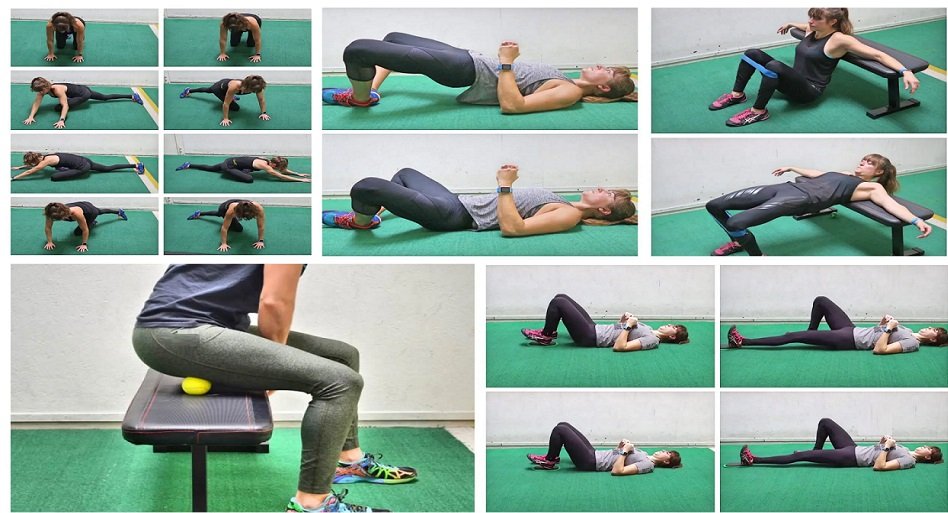
Flexibility is a crucial component of physical fitness, but for many people, tightness and stiffness in the body can make stretching uncomfortable or intimidating. If you’re not very flexible, this 8-minute stretching routine is designed for you. It’s simple, requires no equipment, and addresses all the major muscle groups to help improve your mobility. Say goodbye to complicated yoga poses and advanced stretches—this is all about practical movements that will gently loosen up your muscles and joints.
1. Lumbar Rotation Stretch
This stretch targets the lower back and hips, two areas where many people experience tightness.
How to Do It:
- Lie on your back with your right knee bent.
- Use your left hand to grab the outside of your right knee and gently pull it over to your left side, allowing your body to twist.
- You should feel a stretch through your lower back and hip.
- Hold this position for 30 seconds.
Tip: Keep your movements slow and controlled, and only twist as far as is comfortable for your body.
2. Supine Hamstring Stretch
Hamstrings are often one of the tightest muscle groups, especially if you sit for long periods.
How to Do It:
- Lie on your back with your left leg straight.
- Cup both hands behind your right knee.
- Slowly straighten your right leg toward the ceiling until you feel a stretch in the back of your thigh (hamstring).
- Hold for 30 seconds, then switch legs.
Tip: Be sure not to force your leg straight; aim for a gentle stretch without pain.
3. Piriformis Stretch
The piriformis is a small muscle deep in the hip that can cause discomfort when tight. This stretch can relieve tension in the hips and lower back.
How to Do It:
- Cross your right leg over your left knee, forming a “figure four.”
- Grab your left knee and pull it toward your chest until you feel a stretch in your right hip.
- Hold for 30 seconds, then switch sides.
Tip: This is an excellent stretch for reducing tightness that contributes to sciatica or hip discomfort.
4. Tall Kneeling Hip Flexor Stretch
Your hip flexors can get tight from sitting too much, which can affect your posture and mobility. This stretch helps to lengthen those muscles.
How to Do It:
- Kneel on your right knee and take a large step forward with your left foot.
- Shift your weight forward, keeping your back straight, until you feel a stretch in the front of your right hip.
- Hold for 30 seconds, then switch sides.
Tip: Keep your torso upright and avoid arching your lower back.
5. Kneeling Hamstring Stretch
This is another great stretch for your hamstrings, but from a kneeling position.
How to Do It:
- From the tall kneeling position, shift your weight back onto your right knee.
- Straighten your left leg in front of you.
- Keep your back straight and lean forward from the hips until you feel a stretch in your left hamstring.
- Hold for 30 seconds, then switch sides.
Tip: Engage your core to avoid rounding your back during this stretch.
6. Seated Spine Rotation Stretch
Spinal mobility is essential for everyday movements like bending and twisting. This stretch helps to loosen up your mid and upper back.
How to Do It:
- Sit with your legs out in front of you.
- Cross your left leg over your right, planting your left foot flat on the floor.
- Twist your torso to the left, placing your right elbow on the outside of your left knee for leverage.
- Hold the stretch for 30 seconds, then switch sides.
Tip: This stretch may cause a few pops in your back, but that’s perfectly normal as long as there’s no pain.
7. Child’s Pose Stretch
The child’s pose is a classic yoga stretch that targets the entire back, especially the lats and spine.
How to Do It:
- Start on all fours (hands and knees).
- Sit your hips back toward your heels while reaching your arms forward.
- Tuck your chin into your chest and sink into the stretch, feeling the lengthening in your back.
- Hold for 30 seconds.
Tip: Breathe deeply and let your body relax into the stretch for maximum benefit.
8. Upper Back Extension
This movement opens up the chest and stretches the upper back, perfect for counteracting poor posture from sitting.
How to Do It:
- Sit or stand with your fingertips behind your head.
- Bring your elbows together and fold forward slightly.
- Then, lift your chest and elbows up, opening through your upper back and chest.
- Repeat this movement three times.
Tip: This dynamic stretch is excellent for improving posture and chest mobility.
9. Upper Traps Stretch
The trapezius muscles in the neck and upper back can get very tight, especially if you spend a lot of time hunched over a computer or phone.
How to Do It:
- Tilt your head to the left, bringing your left ear toward your left shoulder.
- Use your left hand to gently apply pressure to the right side of your head.
- Hold for 30 seconds, then switch sides.
Tip: Keep the stretch gentle—this is a sensitive area, and too much pressure can cause discomfort.
Plyometric Exercises
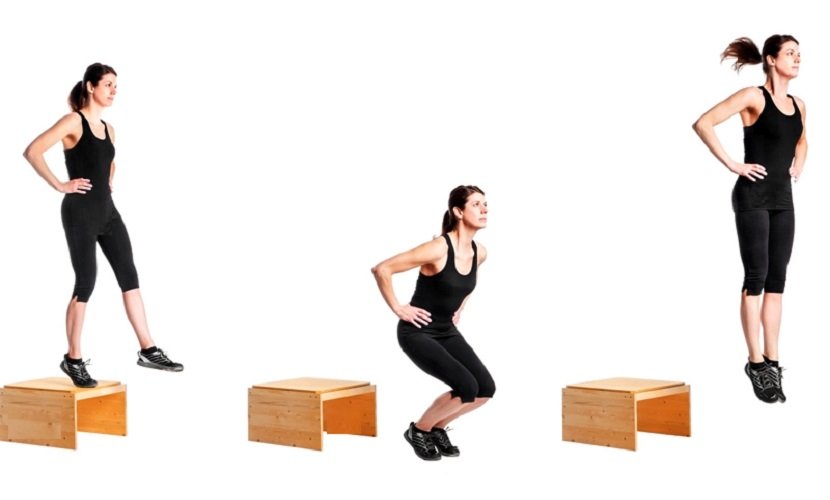
Box Jumps
Box jumps enhance explosive power. Athletes use box jumps to improve vertical leap and agility. The exercise involves jumping onto a raised platform. Box jumps require coordination and strength. Consistent practice increases muscle power and reduces injury risk.
Depth Jumps
Depth jumps focus on rapid force production. Athletes step off a box and immediately jump upon landing. This exercise trains muscles to react quickly. Depth jumps improve neuromuscular efficiency. Athletes gain better performance in sports requiring quick direction changes.
Olympic Weightlifting
Clean and Jerk
The clean and jerk builds total body power. Athletes lift a barbell from the ground to overhead. This movement combines strength and speed. The clean and jerk enhances muscle power and coordination. Regular training improves athletic performance in explosive sports.
Snatch
The snatch develops explosive strength. Athletes lift a barbell from the ground to overhead in one motion. This exercise requires precision and power. The snatch increases muscle power and flexibility. Athletes benefit from improved performance in dynamic sports activities.
Sprint Training
Short Distance Sprints
Short distance sprints boost speed and power. Athletes run at maximum effort for short distances. This training enhances fast-twitch muscle fibers. Short sprints improve acceleration and agility. Athletes gain an edge in sports demanding quick bursts of speed.
Hill Sprints
Hill sprints increase lower body strength. Athletes sprint uphill to build muscle power. This exercise challenges endurance and explosiveness. Hill sprints improve cardiovascular fitness and leg strength. Athletes experience enhanced performance in endurance-based sports.
Case Studies show that integrating these Muscle Power Workouts for Athletes leads to significant improvements. Research highlights the effectiveness of combining strength and ballistic-power training. Athletes achieve better results through targeted programs. These workouts reduce injuries and enhance overall performance.
Programming Ideas for Power Development
Periodization Techniques
Linear Periodization
Linear periodization involves a structured progression in training intensity. Athletes start with high-volume, low-intensity workouts. Over time, the focus shifts to low-volume, high-intensity sessions. This method enhances muscle power by gradually increasing the load on muscles. Research shows that linear periodization can lead to significant strength gains. Coaches often use this technique to prepare athletes for peak performance during competitions.
Undulating Periodization
Undulating periodization offers more variation in training. Athletes alternate between different intensities and volumes within a week. This approach prevents training plateaus and keeps workouts engaging. Studies indicate that undulating periodization can produce similar strength gains as linear models. Athletes benefit from the flexibility and adaptability of this method. Coaches can tailor programs to meet specific needs and goals.
Integrating Power Workouts into Training
Weekly Training Schedule
A well-structured weekly training schedule maximizes power development. Athletes should include a mix of strength, speed, and endurance sessions. Each week might feature two to three power-focused workouts. These sessions could involve plyometrics, Olympic lifts, or sprint drills. Rest days are crucial for recovery and muscle growth. Monitoring progress helps in adjusting the schedule for optimal results.
Balancing Power and Endurance
Balancing power and endurance is essential for comprehensive athletic performance. Athletes should incorporate both elements into their training regimen. Power workouts enhance explosive strength and speed. Endurance sessions build stamina and cardiovascular health. A balanced approach ensures athletes maintain peak performance across various sports demands. Coaches can design programs that integrate both aspects effectively.
-

 Health And Fitness8 months ago
Health And Fitness8 months agoPepsi Zero Sugar vs Diet Pepsi: Which Is Healthier?
-

 Health And Fitness7 months ago
Health And Fitness7 months agoHow to Choose a Rehab for Lasting Recovery
-

 News8 months ago
News8 months agoLondon King Opens Up About Her Relationship with Rob Schneider
-

 News8 months ago
News8 months agoKolkata Doctor Case: Tragic Story of Dr. Moumita Debnath
-

 Tech Innovation7 months ago
Tech Innovation7 months agoHuawei Mate XT: A Detailed Review of the World’s First Tri-Fold Smartphone
-

 News8 months ago
News8 months agoSunita Williams’ Space Dilemma: Never Alone, Always Brave
-

 Sports6 months ago
Sports6 months agoChicago Marathon 2024 Results
-

 Business8 months ago
Business8 months agoTop Payroll Services for Small Businesses in 2024

